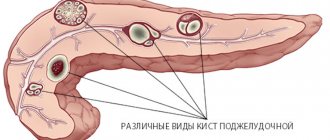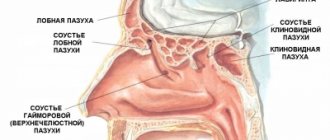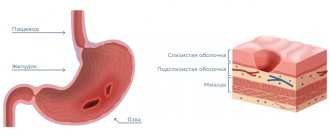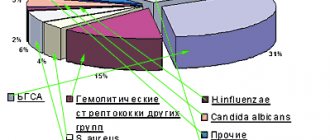Rotavirus gastroenteritis in children
The incubation period lasts from 1 to 5 days when a child is infected with rotavirus gastroenteritis. The disease begins acutely or violently. Manifested by the following symptoms:
- stomach ache
- vomit
- rise in body temperature to 37.5-38 °C (rarely - up to 38 °C)
- bowel disorder.
The vomit is initially abundant, containing food impurities, then becomes watery in nature, and contains mucus impurities in the form of floating flakes.
The child constantly feels sick and his appetite is greatly reduced. Stool occurs from 5 to 15 times a day. It is rich and watery. The color of the stool is yellow or yellow-green. Foamy consistency, pungent odor. In some cases, the stool is cloudy-whitish or scaly, which is similar to the stool of children with cholera.
Older children complain of abdominal pain, which is mainly concentrated in the epigastric region or around the umbilical area. The pain can be either constant or severe cramping, which is similar to attacks of intestinal colic.
The urge to defecate occurs suddenly, almost always accompanied by rumbling in the stomach. Then there is a loud passage of gases and splashing stools. After bowel movement, relief occurs. The mucous membranes of the soft palate, uvula, palatine arches are partially hyperemic and slightly edematous. Enlargement of the liver and spleen is not observed. In severe cases, there may be symptoms such as headache, severe weakness, mild chills, dizziness, loss of consciousness, and convulsions.
Due to the rapid loss of water by the body, children under 12 months may develop isotonic or hypertonic dehydration. In such cases, body weight falls, bloating is observed, etc.
In the peripheral blood in the first days of the disease there may be moderate leukocytosis with neutrophilia; at the peak of symptoms, leukopenia with lymphocytosis is most often found, ESR is within normal limits.
Flow. The disease occurs cyclically. In the first 2-3 days after the onset of rotavirus gastroenteritis, children experience an increase in temperature and intoxication. Diarrhea lasts from 3 to 6 days. In general, the disease lasts from 1 week to 10 days, in severe cases – longer.
The prognosis is favorable in almost all cases. Isolated cases of illness in infants under 12 months of age result in death, when severe dehydration and cardiovascular and renal failure develop.
Complications can arise due to the addition of a bacterial or viral-bacterial infection and almost always occur in young children.
Infographic: gastroenteritis
Each season has its own disease. In winter and autumn we are faced with the traditional cold season, in the spring people suffer from hay fever, and in the summer, especially in August, there is a peak in cases of gastroenteritis.
Gastroenteritis is inflammation of the mucous membranes of the intestines and stomach. It develops under the influence of toxins from viruses and bacteria that enter the body. Everyone has suffered from gastroenteritis at least once in their life. It occurs especially often in children under 5 years of age. The immune system of children is usually weaker than that of adults, which means that it is much easier for bacteria and viruses to penetrate a child’s body.
How does gastroenteritis occur?
The main causative agents of intestinal infections are viruses; they are responsible for approximately 70% of cases of gastroenteritis. Most often, the culprit is rotavirus, and in general almost two dozen different viruses can cause unpleasant symptoms.
Viruses spread through contact: you can become infected by touching objects or products that an infected person has touched. That is why you should not try unwashed peaches at the market or taste watermelon cut by the seller right on the counter.
About a third of cases of gastroenteritis are caused by bacteria. The most common causes of gastroenteritis are Salmonella, Campylobacter, Yersinia and Shigella. They enter the body when eating unwashed or spoiled foods. This happens much more often in the summer, because warm weather promotes the growth and spread of bacteria.
Bacteria that come into contact with a suitable nutrient medium - dairy products, meat, seafood - begin to actively multiply. Each cell divides once every 20 minutes. This means that every thousand bacterial cells turn into more than 30 million bacteria in 5 hours. The barbecue meat that you spent half a day defrosting in the sink, or the milk in the mug that you forgot on the veranda in the morning is literally teeming with germs.
Symptoms mild to severe
Don't let yourself dry out
| Symptoms of viral gastroenteritis: | |
| severe runny nose; cough; sore throat; increased body temperature; headache; vomit; diarrhea; dry mouth. | |
The most dangerous consequence of gastroenteritis is dehydration. Due to incessant vomiting and diarrhea, the body quickly loses water, and with it useful microelements. As a result, this can lead to low blood pressure, fainting, and, if medical attention is not provided in time, kidney failure. Therefore, if you suspect an infection, it is important to consult a doctor without wasting time.
Drinking plenty of water will only help cope with thirst, but will not restore the water-salt balance. Therefore, patients must be hospitalized in the infectious diseases department. Here, based on the results of a scatological examination, the pathogen is identified and appropriate therapy is prescribed.
Gastroenteritis
In case of an acute process, treatment can be carried out on an outpatient basis or in an infectious diseases hospital, in case of a chronic process - in the gastroenterology department. The basis of therapy for the acute form is rehydration, diet therapy, and in some cases, the use of antibiotics and auxiliary agents. Any severity of acute infectious gastroenteritis requires early initiation of oral rehydration therapy. This is especially true for young children, in whom dehydration develops very quickly. Even if there are no signs of exicosis, drinking plenty of fluids is required.
In case of thirst, dry skin, or decreased urine volume, special oral saline solutions are used. The patient should drink fluid in a volume exceeding one and a half times the loss. If thirst decreases and diuresis increases, it means that dehydration is sufficiently compensated. In case of significant losses of water and electrolytes, infusion rehydration with saline solutions is performed.
Antibiotics in the case of acute gastroenteritis are indicated only for its bacterial etiology (the presence of mucus, pus and blood in the stool, severe hyperthermia). In case of viral infection, antibacterial therapy is contraindicated. To reduce diarrhea and remove toxins, enterosorbents are prescribed: activated carbon, dioctahedral smectite, polyphepane and others. To normalize the intestinal flora, probiotics and eubiotics are used.
Treatment of chronic gastroenteritis is determined by its form. In case of increased acidity, antacids and proton pump inhibitors are used. Detection of Helicobacter requires specific therapy: antibiotics, bismuth preparations and proton pump inhibitors are prescribed. For low acidity, natural gastric juice, enzymatic and reparative drugs are used. The intestinal microflora must be restored. For severe pain, especially with symptoms of solaritis, physiotherapy is effective: electrophoresis with anesthetics, magnetic therapy.
In acute and chronic forms of the disease, diet must be followed. Food should be chemically and mechanically gentle; extractive substances, fatty and spicy foods are excluded. In order to reduce the risk of relapse, patients are advised to avoid smoking, drinking alcohol, coffee and carbonated drinks. During the period of remission, sanatorium-resort treatment is carried out. Therapy for gastroenteritis should not be carried out by patients on their own - the irrational use of symptomatic remedies only reduces the symptoms, but does not lead to a cure.
From sick to healthy
This disease is better known as intestinal flu, although it has nothing to do with the classic viral flu. In more than half of the cases it is associated with food poisoning. The source of infection is often exotic fruits, meat and seafood, and confectionery products sold from stalls on the streets. As well as tap water and swimming in local rivers (not in the sea!).
With low-quality food products, pathogenic bacteria enter the body - salmonella, shigella, E. coli, staphylococcus. As a result of intoxication, the synthesis of digestive enzymes is disrupted, digestion and metabolic processes deteriorate.
Another cause of gastroenteritis is rotaviruses. They are very contagious, meaning it is not difficult to become infected with them.
In 90% of cases, infection occurs in the traditional way for intestinal infections - through dirty hands. Less commonly, the disease is transmitted by airborne droplets from a sick person.
The first signs of gastroenteritis appear on the same, maximum on the second day after infection. The course of the disease depends on whether viruses or bacteria caused it.
All in your hands
Gastroenteritis is one of those diseases that can be easily prevented. For specific prevention of rotavirus infection, there are two vaccines that have undergone clinical trials. Both contain a weakened live virus and are taken orally.
You can also avoid infection by following basic hygiene rules:
- wash your hands before eating;
- pay attention to the expiration date of food products and monitor their storage temperature;
- drink only filtered or bottled water, exclude all drinks with ice;
- prepare cuts on clean cutting boards;
- wash vegetables, fruits and herbs thoroughly;
- do not eat raw eggs;
- buy food and drinking water only in supermarkets;
- Carry alcohol or wet wipes with you to disinfect your hands.
Diagnostics
Photo: beautymedicaltouch-usa.com
Most often in practice, infectious gastroenteritis occurs, the symptoms and diagnosis of which depend on the type of pathogen. However, the reason may also be the damaging effects of drugs and chemicals that are aggressive to the mucosa. Gastroenteritis is not an independent nosological entity and usually represents a symptom complex of manifestations of other diseases.
Diagnostic methods
Diagnosis of gastroenteritis consists of examining the patient, collecting an anamnesis of his disease, differential diagnosis with similar pathologies, and the use of laboratory and instrumental research methods.
As a rule, diagnosis of gastroenteritis can be made based on examination and complaints of the patient. Signs of gastroenteritis can vary in severity. It all depends on the nature of the disease, its etiology, severity, age of the patient, and concomitant pathologies.
The disease manifests itself suddenly.
Patient's complaints
The main complaints are as follows:
- lack of appetite;
- weight loss;
- nausea, vomiting;
- rumbling in the abdomen;
- pain of varying intensity of a spastic nature;
- diarrhea of various types;
- muscle pain;
- general severe weakness;
- feeling of bloating;
- temperature increase.
Diarrhea may be absent, but this does not exclude the presence of rumbling in the abdominal cavity, which is one of the specific features of this disease, which facilitates the diagnosis of gastroenteritis.
Vomiting and diarrhea can be so significant that they sometimes provoke dehydration with corresponding manifestations: decreased blood pressure, increased heart rate, and renal failure.
Increased temperature: it can vary from low-grade to high, depending on the pathogen.
Features of the disease depending on the pathogen
With viral etiology, the main manifestation of gastroenteritis is loose to watery stools. Rarely there are mucus or blood impurities.
Rotavirus causes significant intoxication. The temperature is often low-grade, but can sometimes rise to high levels. Vomiting is typical. The acute period lasts about a week.
Caliciviruses are characterized by an acute onset of the disease with severe vomiting and spasmodic pain of significant intensity. Vomiting is more pronounced in children, and diarrhea in adults. Often all this is accompanied by headache and muscle pain. This period does not last long - 1-2 days.
Under the influence of adenoviruses, the disease lasts a long time - 2-3 weeks. Vomiting is not expressed. Begins 1-2 days after diarrhea. In half of the cases, an increase in temperature is observed, but rarely to high levels.
Bacterial gastroenteritis is accompanied by severe intoxication symptoms: high fever, severe general weakness. Severe diarrhea, accompanied by bleeding. Some bacteria synthesize large amounts of enterotoxin, which causes profuse, watery stools.
Parasites do not cause acute symptoms. As a rule, gastroenteritis caused by them develops with mild diarrhea. Blood in the stool is rare. Only for amoebic dysentery. Characterized by severe general malaise and weakness.
Differential diagnosis
Differential diagnosis is carried out by analogy with acute diseases of the abdominal organs (appendicitis, ulcerative colitis, cholecystitis).
Gastroenteritis is supported by watery diarrhea, consumption of potentially contaminated food, and the presence of the disease in others.
Stool examination
The attending physician determines what tests should be taken if gastroenteritis is suspected. A rectal examination is performed. Feces with gastroenteritis are indicative. If blood and watery diarrhea persist for more than a couple of days, a test is carried out for occult blood, for the content of parasites and their eggs in the feces, and a bacterial culture is carried out.
An enzyme-linked immunosorbent method can be used to determine the presence of lamblia and some viruses. However, such studies are carried out only in the event of a disease outbreak.
All patients who have bloody diarrhea must be tested for the presence of E. coli.
If bloody diarrhea occurs in adult patients, sigmoidoscopy is performed. In this case, a biopsy is taken and culture of the contents is taken to test the blood for gastroenteritis.
General tests for acute gastroenteritis
General blood tests for this pathology are not very specific. A general blood test for gastroenteritis can reveal inflammatory manifestations and an increase in the level of eosinophils. In severe cases, the number of electrolytes may change, which requires their correction.
Diagnosis, as well as treatment, should only be carried out by a specialist. Self-diagnosis can lead to erroneous diagnoses and, consequently, complications.








